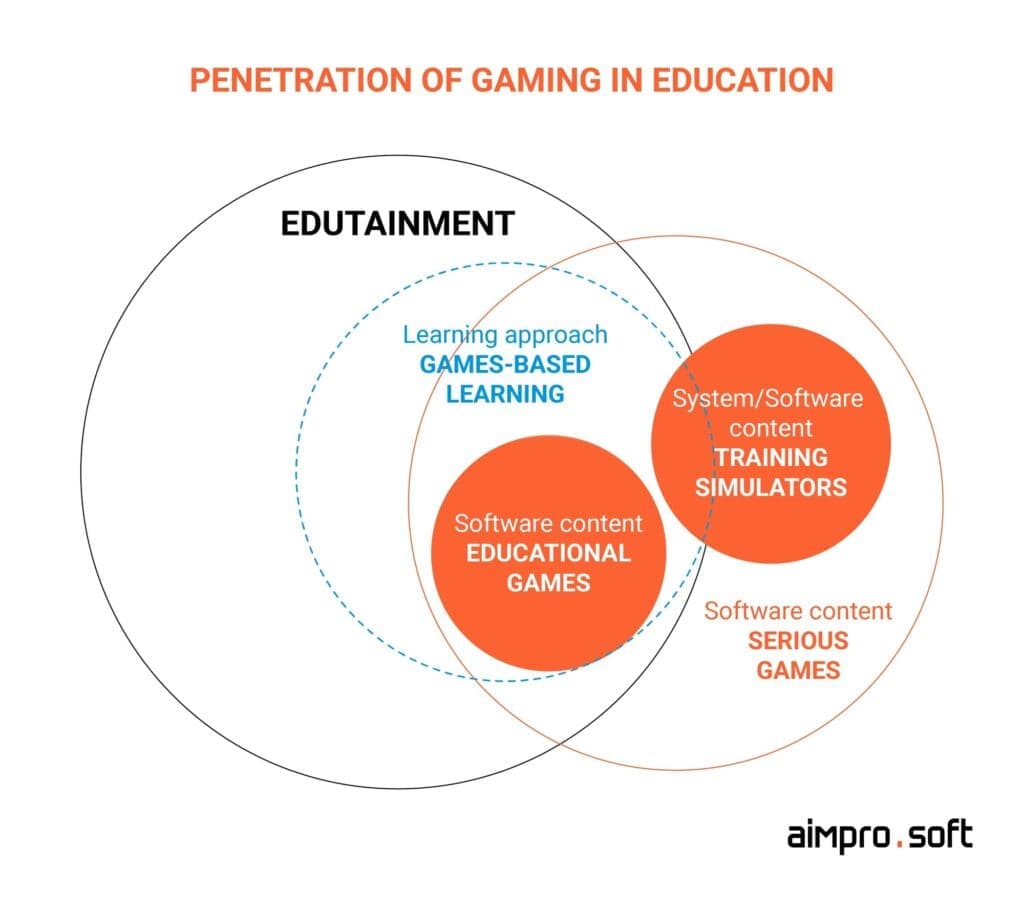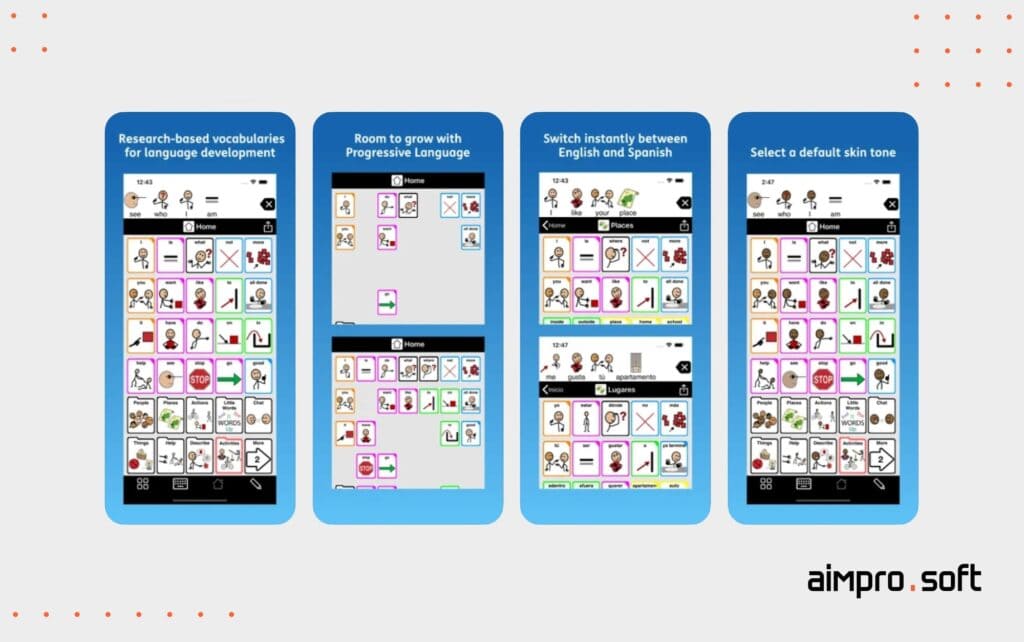Gamification in Learning Apps to Make Education Fun and Get Positive Outcomes
Key takeaways
-
The gamification in learning apps is caused by people’s passion for entertainment and gaming. We will cover how to leverage it in digital education.
-
Psycho and neuro influencers lay at the core of the human attitude to learning. We’ve touched on why gamification works in harmony with the human brain.
-
The eLearning industry borrowed a lot from games more than others. You can learn the most commonly used features stolen from games that effectively work in education.
-
Gamification for employees’ productivity: making the team stronger, retaining talents, and extending expertise with reasonable investments.
-
Aimprosoft’s case: contributing to the 2nd most popular educational app.
Americans spent over $49 billion on video games in 2020. Definitely, the entertainment is worth the candle. Gaming penetrates all possible industries, and learning is not the exception. Experts forecast $17.56 billion in revenue for the gamification market by 2024, primarily due to the emergence of gamified learning tools.
The globalization of higher education, thrive for personal development, the emergence of customer engagement platforms, employee performance, and adaptation is far not a complete list of spheres where gamification is appropriate.
People love playing games, while life-long learning is purpose-based for human evolution. Whether we like it or not, we are constantly learning. We have it on instinct. Keep on reading to know how effectively combine these attributes to leverage favorable outcomes for your business, incorporating gamification in education apps and creating innovative products.
Gamification in learning as a central element of the Human-Focused Design
Before deciding to use gamification elements or not in the learning app, it’s worth figuring out what is behind the term, whether you need to invest in the game-like ingredients in your business to follow the fashion because it affects the cost to make an educational app.
In 2021 Yu-kai Chou, the author of the well-known book “Gamification & Behavioral Design,” created a term “Human-Focused Design” that refers to human motivation rather than traditional human-function performance as concerns the focus is on getting the job done quickly mechanically without delay. With the rise of technologies, the gaming industry seized the opportunity to master human behavior.
In response to it, other industries started using game-inspired elements to deliver an interactive user experience. The eLearning industry flourished by adding them to most training or educational programs. It resulted in the emergence of the second topic-related term, “edutainment.”
Edutainment is a learning concept derived from “education” and “entertainment” that implies the distribution of educational content via an entertaining approach. The main goal of gamification for education apps is to learn the target audience of students while entertaining them. For example, videos, virtual assistants, lectures, upskill programs can be and should be gamified for a reason.
Electronic gamification is a process that integrates game mechanics into the learning process. It is mainly used to motivate people to make the process more fun and enjoyable. Educational gamification uses game designers’ techniques to engage their players and reward their progress in action.

Deloitte has initiated a discussion about the paradox of innovation that states that although companies invest over $3.8 trillion in IT, 92% of respondents admitted new technologies for training as ineffective. Why are corporations going broke with investments in employee learning? Users found all these technologies difficult to use on a daily basis.
What’s the way out?
Pivot to the natural human-focused needs by providing intrigue, motivation, and fun. By making learning game-like, you can achieve tangible goals. In other words, gamification makes boring tasks interesting, avoidable tasks desirable, and complicated tasks simple.
Three hormones are at the heart of the success of your educational application: serotonin, dopamine, oxytocin. Let’s discover by what gamification carries out its mission to enhance certain human abilities, provides learning with a purpose, supports students behavior change, engage, and socialize.
The psychological and neurological aspects of gamification and their positive effect on learning
This technology has won its place in the educational scene among eLearning trends. Modern students, born in the digital age, are spoiled with a diversity of entertainment around them. Retaining their attention becomes more complicated with the human attention span dropping from 12 to 8 seconds since 2000 when a goldfish has its 9 seconds, by the way.

Since one of today’s most painful challenges is user retention, businesses, and educational institutions resort to the gamification of learning applications as it can increase retention rates up to 17%, according to Stephen Baer, Head of Creative Strategy & Innovation at The Game Agency.
Surely game-based learning (GBL) can upgrade skills instead of driving social loafing? Let’s elaborate on it.
Dependance on reward keeps up intrinsic motivation
The reward is a special case of motivation, one of the methods of motivation that is highly dependent on the satisfaction and joy received from the process or result. It is common in education to use the term positive reinforcement. In the case of app gamification, this can be accomplished with instant comments from the virtual assistant on every student action that is considered positive.
To ignite motivation in upskilling social media in a business context, they decided to create an e-learning website in Cisco for a multi-level learning program with game elements. Thus, prior dispersed knowledge was delivered in structured lessons with digital certifications encouraging to take over 13,000 courses level by level for over 650 individuals.
Remembering past successes is another thing that reinforces a person’s good mood. From a physiological point of view, serotonin is responsible for this. How can this be used for the gamification of learning applications? A collection of honor board badges in a gamified LMS or can return learners to their awards, feeling their significance and acquisition value.
Positive emotions form a loyal attitude to learning
Dopamine rewards us with feeling good. It is released whenever we are rewarded for a certain action. The gamification in education application provides learners with instant rewards through feedback, which is less readily available in traditional learning. Students begin to associate learning with positive emotions by receiving a virtual reward in virtual currency, badges, and assignment of statuses for achieving learning goals, which contributes to the desire to repeat the action (learning) and get the release of dopamine into the blood.
Games offer enjoyment and excitement. The experiment implementing the challenge-based gamification positively impacted student learning in contrast to conventional education methods. Challenges, points, levels, and leaderboard in the application Horses for Course led to students’ performances improvement by 34.75% regarding a statistical forecasting topic. Students tend to study dry statistical approaches more favorably with gamification, which can be a valuable educational tool as solo or a part of traditional teaching methods.
Let us help you with that by building the right learning app.
Contact usEngagement in learning is linked to the interest in it
There was developed a leadership program for senior executives in Deloitte. It lacked a structural impulse to engage very busy men to start and complete the curriculum that was considered to bring a positive impact. After putting badges, leaderboards, and status symbols, the gamification of the learning app did the trick: addicted to overcoming competitors who were co-workers, the C-suite began to pass the certification by 50% faster and visit the website twice frequent.
Learning is about reasonableness. Learners crave to be sure that obtaining the particular knowledge is relevant to their needs. Dr. Michiko Sakaki from the University of Reading noted that by learning people are more attentive to the vivid information rather than dull static content, which exalts emotional connection with the subject of learning to the highest level. Thus, the game concept encourages students to be more engaged in their courses, which leads to higher completion rates with higher assessments. Everything we do, we do to achieve something. A sense of achievement is a good psychological factor.
Gamification influences cognitive development
Despite the enormous capabilities of our brain, it is still limited in processing a certain amount of information. With too much cognitive load, an adult learner may miss some information caused by the overload during studies, leading to incomplete mastering.
As for children, for whom the learning process takes a longer part of life than for adults, and at an early age is decisive for the overall development of the brain, harmonious cognitive development lays down the skills of perceiving and analyzing information from the outside world.
The game format helps to cope with both problems: splitting tasks with long-term goals into smaller ones with mid-term and short-term goals flavored with game elements reduces stress during completing tasks and keeps the interest in continuing to learn new things developing cognitive functions.
People trust to storytelling and fairytelling
People tend to remember stories better than dry tables, clear-cut structures, and formulas. Because we are creatures of emotions. This is due to our physiology. When people engage in a strong narrative with a good storyline, they have more confidence in the subject matter and its process. The hormone oxytocin is responsible for this, which turns on in the human brain the function of accepting information in the narrative as more reliable.

An exciting plot in the training course or creating a story by learners forges connections between people and ideas. Kid in Story Book Maker allows kids to participate as characters in social stories they follow, inserting their photos into a template with recorded voice. It increases involvement in foreign language learning delivering positive outcomes and children’s engagement.
Let’s revive it to life with gamified elements.
Contact usIt makes education accessible for special people
Gamification for educational apps makes sense for people with special needs by fostering independence in learning and improving outcomes. Research studies on technology’s impact on development skills among people with a developmental disorder concluded that game-like interventions help in mastering skills.
For example, an iOS Proloquo2Go app allows students with speech impediments caused by developmental disorders (ADS, cerebral palsy, Down, etc.) to improve communication. Everybody can choose from available accents, the closest to their inner voice, to express themselves. It looks like a real chance to help young people by satisfying needs in a narrow specific niche.

By making a preliminary conclusion, a problem of involvement in the educational process that exists both among young people and adults can be solved by business addressing the essentials. Gamification in education uses the natural desire of people to socialize, learn, achieve, compete, etc., which removes the difficulties and discomfort in learning.
Instead of being forced to do something leading to a drop in motivation, let the students feel they are driving to think that they are in control of their destiny. There are many reasons to use gamified learning methods in education. Done right, it can embrace powerful human emotions and generate a positive learning experience.
Let’s overview the main elements borrowed from games to make education more resultful.
Steal like an artist from games for gamification in education apps
Education took over some distinctive features from games that can help you create an educational app.
| Game features | Their role in learning |
|---|---|
| Users are participants | Are central in education as well as players in games. So this works in your favor while making gamification of the learning app: people achieve goals via entertaining. |
| Teamwork | Brings tangible benefits for learners in developing collaboration and communication skills as well as solving difficult problems by brainstorming, which is highly effective in groups. |
| Storyline with avatars | Immerses people in another world. It allows making the educational process less stressful but at the same time captivates to continue learning. |
| Defined objectives | Are the endpoints for learners on their paths helping form knowledge and methods of activity, increase the general level of mental development, and change thinking. |
| Points system | Nudge learners to be actively involved and acknowledge the best. It increases confidence, betters grades, encourages motivation, and endorses effort resulting in better outcomes. |
| Levels | Showcase the passed courses. Also, it is an excellent way to group content by creating customized learning pathways that are relevant to vital learners’ needs. |
| Leaderboards | Act as scoreboards to display the ranking of the leaders in learning according to their accumulated gamification points. |
| Badges | Are the visual representation of particular skills that allow the students to measure their achievements of the course completion in the game context. |
| Ranking | Reflects success and achievements in gaining knowledge and motivates to raise the level. The ranking position is defined by the received points. |
| In-game currency | Virtual currency can be used to encourage people to practice more courses and can be fully or partially converted into real money as a reward. |

Scenarios of how gamification in learning apps can help to adopt better habits among employees
The greatest do not wait for opportunities; they create them. There is always a place for digital transformation in education among content providers and software vendors in the sector of corporate learning. Let’s see how common tedious processes can become a thing to enjoy with gamification in online learning applications.
Onboarding
A half of new employees admitted gamification as a key helpful element in the onboarding training. Custom-developed solutions or tailored ready-mades are able to encourage engagement of new hires with your company and employees. You can create a fascinating level-based journey across specific web sections in your company intranet or LMS with characters and the ability to earn prizes that can be converted to real gifts.
Marugame Udon, a restaurant chain in Japan and the USA, leans on mobile-friendly onboarding training in their strategy to match their business specificity – hospitality. By incorporating gamified simulations, new hires mastered new practical skills faster and more manageable way being ready to get to work earlier.
Productivity and retention

47% of HR professionals placed employee retention to the top list of workforce management challenges since pandemic despite dismissals. Another survey from TalentLMS revealed that 89% of employees bind their higher productivity at work with gamification. Creating competition with awards for a passed course increases effectiveness and retention.
Gamification in the elearning application converts employees’ obligations into a willingness to perform training. In the workplace, a piece of entertainment forms a great brand experience as 69% of employees stated to stick around in the company for over three years that use gamified activities.
Upskilling
It is a confrontation concern for leaders to decide on acquiring expertise from outside or cultivate skills among existing employees. Recruiting takes a lot of effort to find the right expertise on the market, especially in talent shortage conditions among many specialists demanded nowadays. 69% of employers found themselves in difficulty to fill jobs.
Digital Fitness app by PwC teaches people digital literacy and awareness of any profession. Adding a digital layer is achieved through a series of questions during 15 mins in a readable and media content format seasoned with a gamified digital fitness score.
We can help do it in an affordable way. With technologies
Contact usSoft skills improvement
Deloitte Access Economics, in their study, predicts that despite global automation, two-thirds of jobs in Australia will reckon on soft skills by 2030. Although, active automation of mundane, repetitive tasks won’t replace traits inherent only to humans, such as empathy, creativity, emotional intelligence, and imagination. Stephen Farrell, VP at Faethm, is sure machines can’t adopt them. A piece of gaming makes its way into the arena to maintain these abilities and use them to your advantage.
Sales training
Sales brain likes to win more than ordinary human one. Sales representatives must learn and memorize a large amount of product information and improve their negotiation skills.
For example, SalesScreen gamifies the routine acknowledgment of new knowledge and educates employees in a fun way while encouraging healthy competition. Sales reps can detect potential issues in the sales pipelines. One-to-one coaching and competition motivate them to increase their professional level. Moreover, there is an identification of individual KPI trends available for sales roles to make coaching custom.
Compliance training
The more severe subject is, the harder it is to master for newbies. Dry regulatory topics like guidelines and specifications relevant to its business processes, industry-specific regulations as GDPR, PHI, organization’s adherence to laws, punishments for violations, etc., are from the category that should be thoroughly studied. An on-screen character, progress bars, scores, etc., can enormously increase involvement and completion, making the training less boring.
A custom or ready-made compliance LMS seemed like the clear avenue to take for workforce comprehension of fundamentals in health and safety, fire awareness, soft skills, and others. NAWT, the UK’s top animal welfare charity, gained positive outcomes by interactive courses, which, apart from the rose awareness, resulted in reducing costs for training.
Leadership training

People playing games are wholly absorbed at this moment to gain personal satisfaction in reaching the next level. The same level of engagement can be reached by gamified training for leadership to skyrocket solving critical problems and creating innovative products or services.
For example, the Japan outsourcer NTT Data by using game elements to improve leadership skills in the company led to the fact that after completing the training, more than half of the employees moved to higher management positions, reduced leaving from the company by 30%, and saved spendings on personnel hiring and reskilling.
Building inclusive teams
Pens and paper are replaced with mobile apps, which allow creating virtual fairy worlds with fictitious roles to develop valuable practical skills in a world of distance work. A fun-education balance induces uniting team members and evolving trust among each other, encouraging collaboration, improving communication, and other vital skills through high engagement and enjoyment.
The concept of a talent development platform is widely used among employers who care about cultural intelligence in the workplace. Mayo Clinic’s staff demonstrated positive results gained by introspection and self-reflection after getting trained on the KeepWOL platform. A gamified facilitator for teams turned out to be valuable, enabling employees to build connections at work through immersive experiences.
Wrong gamification in learning apps that can break your business
Case: Microsoft vs Duolingo
All of us remember that dog Rover, the Search Companion in Windows XP. It was an example of an irrelevant avatar out of context. A cartoon character appeared to accompany the user’s actions while searching. It gave a little fun, but soon it got bored quickly, being out-of-place. The dog distracted a user’s attention. It’s good that there was an option to turn it off.
On the contrary, Duolingo creating a language learning app took the best for gamification of the elearning mobile app, adding a lovely green owl mascot at times serving as a coach as an alternative to teachers. In this case, it is the proper context for the on-screen character, like when visual design elements are used for encouragement during lessons.

Here is the list of most popular mistakes you can avoid by developing your gamified app:
- Surplus of gamified elements;
- Neglecting eLearning navigation design;
- Centering rewards more than results;
- Game mechanics out of context (complicated or scanty);
- Omitting social learning opportunities for collaborative interaction;
- No or poor directions for users on taking actions;
- Imbalance in favor of сompetition over learning
Why Aimprosoft can gamify your learning application
Our client from Scandinavia wanted to improve their educational app for kids with new features and a tech stack. As an education software development company, we delivered two cross-platform React Native-based apps for teaching math to children of two age categories. It positions itself as the children’s digital math teacher.
Thus, the aim to offer more affordable education to local children was accompanied by the goal to make it engaging and motivational as the users of the self-education platform are the most demanding audience. The gamification features Aimprosoft implemented to make the process captivating are animation, animated confetti, gifts for correct task completion, and others. It has a series of gamified tasks to resolve, categories, and levels of difficulty. The educational content is divided into sections, topics with manageable progress checks.
Now the application has a stable second position in the market of the country, thanks a lot to the contribution of the leading experts in math and education and chosen game-based engagement model.
Conclusion
The most beautiful and complex ideas in the whole universe are built on basic ideas.
Monitoring changes is good, especially when needed. The educational process has not stopped developing over the years, and it definitely does not need to be stopped now. It is imperative to go hand in hand with the new digital era and adapt to our current needs. Gamification in education fits this.
With all the physical and psychological evidence of how gamification in education and teaching techniques affect our learning, it is clear that change is heading in the right direction. Making a focus on mobile apps for learning is a chance for you to start an EdTech company in 2023 with a precise product-market fit because 70% of mobile learners prefer to study via smartphone. Contact us to get results from education.
FAQ
How do I create a gamification app?
The steps are similar to mobile development of any other mobile app, starting with busyness analysis to document use cases based on your gamification strategy, then prototyping and design, iterated development (native or hybrid) for one or platforms, testing stage, release, maintenance, and support.
What are the classic examples of gamification in mobile education apps?
You are most likely familiar by hearsay with the following digital classroom apps for learning that encourage users to play and learn with gamified elements:
- Khan Academy: an educational platform for gaining knowledge from a wide variety of fields
- Tinycards: teaching a subject with flashcards
- Coursera: an educational platform that provides an Ivy-League education for everybody
- Memrise: a language learning app through locals
- Duolingo: a free language learning app favored by millions
Can I include gamification for the e-learning app I already have?
Yes, you can. Nothing is impossible. A gamification strategy, as usual, emerged at the idea stage: you probably know intuitively or based on the market research what to offer users for motivated learning. However, you can add entertained features to your existing app to make it more engaging and result-purposed.




